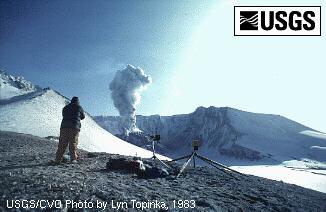Who's Keeping Watch Over Cascades Volcanoes?The U.S. Geological Survey (USGS)Who's Keeping Watch Over Cascades Volcanoes? The U.S.Geological Survey (USGS): USGS Open File Report 97-125 |

The USGS Observes, Measures, and Studies Volcanoes in the CascadesThe USGS Cascades Volcano Observatory (CVO) in Vancouver, Washington, was founded in 1980 following the devastating eruption of Mount St. Helens. It is one of three such observatories in the country today (others are in Hawaii and Alaska). Observatory scientists, technicians, and support staff work in partnership with colleagues at other USGS centers, universities, and other agencies to:
The USGS Works to Prevent Volcanic DisastersIn the past 200 years, seven volcanoes in the Cascades have erupted, and Cascade eruptions can trigger a variety of hazardous processes. Areas within 10 to 20 miles of erupting volcanoes can be devastated by flows and blasts of hot rock and superheated air, and valleys may be exposed to high concentrations of lethal volcanic gases (also possible during noneruptive periods). Volcanic ash can rise high into the air to drift with the wind, threatening aircraft and disrupting life on the ground hundreds of miles downwind. Eruptions (and sometimes giant landslides not related to eruptions) can also send floods or torrents of mud and rock hundreds of miles down river valleys. The USGS works to prevent loss of life and property from these catastrophic processes here in the Pacific Northwest and elsewhere.
The USGS Sends Rapid Response Teams to Areas of Volcanic CrisisThe core of the USGS volcano rapid response team is located at CVO. Team members are capable of responding within 24 hours to threatening volcanic activity anywhere in the US or the rest of the world. USGS staff have the experience that is often needed and requested by the U.S. Agency for International Development (Office of Foreign Disaster Assistance) for crisis situations in many countries. The additional experience gained from work at foreign volcanoes greatly strengthens the USGS program because it provides a training ground where skills are sharpened, experience is broadened, and equipment is tested. USGS scientists then are better prepared to respond to volcano crises at home.
The USGS Provides Information, Products, and
|



